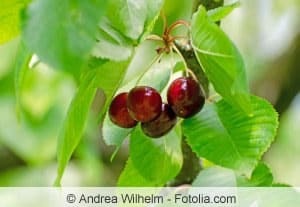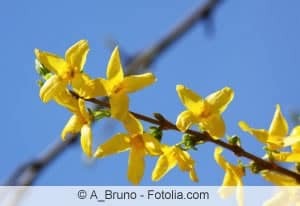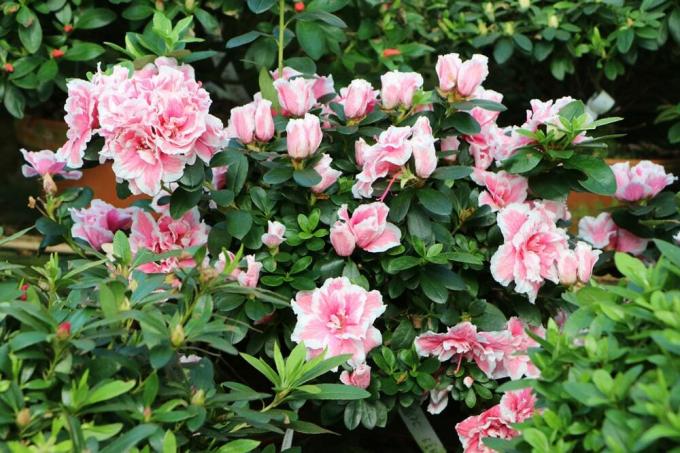

Table of contents
- trees in the garden
- Classification according to growth height
- Classification according to leaf shedding
- Deciduous trees
- Various species of large deciduous trees
- Evergreen deciduous trees
- conifers
- shrubs in the garden
- Shrubs with flowers (flowering shrubs)
- Fruit bushes (fruit and nut bushes)
- Classification by root type
- Conclusion
Trees and shrubs are very popular in hobby gardens as privacy screens and shade providers. But they do different jobs. They also have different flowering times and growth heights. Some shrubs and trees bear fragrant flowers, others do without flowers. There are evergreen and deciduous trees and shrubs. When choosing plants, it is always important for the hobby gardener to know how the plants are made. That is why we have compiled a list of the most common shrubs and trees in the garden for you.
trees in the garden
Trees are woody, long-lived plants. They have a trunk that tapers upwards, giving rise to thicker branches and thinner, leafy twigs at the top. Trees form so-called crowns.
Classification according to growth height
Depending on their growth height, trees in the garden are divided into small trees (trees of the third order, growth height 2 to 10 m), medium-sized trees (trees of the second order, height of growth 10 to 20 m) and large trees (trees of the first order, height of growth over 20 m) assigned. Some of the small trees also grow as so-called large shrubs. Large trees are rarely planted in hobby gardens because of their very large growth and when they are, they are as so-called house trees in a single position near the house or in large garden meadows to meet
Classification according to leaf shedding
Furthermore, the trees can also be divided into deciduous trees, i.e. deciduous trees that shed their leaves, evergreen deciduous trees and conifers:
Deciduous trees
These trees lose their leaves in the fall, unlike the deciduous evergreens, which keep their leaves through the winter.
Different types of deciduous small trees:
- Maple (Acer) for example field maple (Acer campestre), fire maple (Acer ginnala) and Japanese maple (Acer palmatum)
- Crabapple (Malus) in different varieties with red flowers and small fruits
- Spindle bush (Euonymus europaeus) with green-white flowers and red fruits - poisonous
- Oleaster (Elaeagnus angustifolia)
- Los tree (Clerodendrum trichotomum)
- Tulip magnolia (Magnolia x soulangeana)
- Hawthorn (Crataegus laevigata 'Paul's Scarlet')
- Catkin willow (Salix caprea 'Mas')
- Elderberry (Sambucus) – also grows as a shrub
- Medlar (Mespilus germanica) – fruit tree
- Crabapple (Malus sylvestris) - fruit tree
- Plum (Prunus domestica) - fruit tree
- Sour cherry (Prunus cerasus) – fruit tree
- Common hazel (Corylus avellana) – also found as a nut bush
- Ornamental cherry (Prunus serrulata) in different varieties with red leaves and red drupes
- Various species of deciduous medium-sized trees
- Whitebeam (Sorbus aria)
- Serviceberry (Sorbus torminalis)
- Purple ash (Fraxinus angustifolia 'Raywood')
- Norway maple (Acer platanoides 'Columnare')
- Tree hazel (Corylus colurna) with a conical crown and fruits in clusters - walnut
- Walnut (Juglans regia) with spreading crown - Walnut
- Service Tree (Sorbus domestica) – fruit tree
- Late flowering bird cherry (Prunus serotina) - fruit tree
- Sweet Cherry (Prunus avium) – fruit tree
Various species of large deciduous trees
- Birch (Betula) in different varieties
- Beech (Fagus sylvatica) in different varieties
- Maple (Acer) in different varieties
- Hornbeam (Carpinus betulus) is also often used as a hedge shrub
- Oak (Quercus) in different varieties
- Ash (Fraxinus) in different varieties
- Gingko (Gingko biloba)
- Elm (Ulmus) in different varieties
- Lime (Tilia) as summer and winter linden
- Poplar (Populus) in different varieties
- Black Locust (Robinia pseudoacacia)
- Horse chestnut (Aesculus) in different varieties
- Chestnut (Castanea sativa) – walnut
Evergreen deciduous trees
Small, evergreen deciduous trees
- Bay cherry (Prunus laurocerasus)
- Evergreen boxwood (Buxus sempervirens) usable as a hedge shrub - poisonous
Medium-sized, evergreen deciduous trees
- Holly (Ilex aquifolium) with red fruits
conifers
Conifers are also often referred to as conifers. They have tough and hard, narrow leaves that appear needle-like in most conifers. The leaves are very resilient and remain on the tree even in winter.
Small conifers
- Dwarf columnar juniper (Juniperus communis 'Compressa')
- Korean fir (Abies koreana)
- Various types of cypress (Chamaecyparis).
- Dwarf spruce (Picea glauca 'Conica')
Medium sized conifers
- Common juniper (Juniperus communis)
- Spruce (Picea)
- Yew (Taxus baccata) - poisonous
- Pine (Pinus) in different varieties
- Occidental tree of life (Thuja occidentalis) – poisonous
Large conifers
- Sequoias (Sequoioideae)
- Larch (Larix decidua)
- silver fir (Abies alba)
- Douglas fir (Pseudotsuga menziesii)
- Red fir (Picea abies)
- Blue spruce (Picea pungens 'Glauca')
- Black Pine (Pinus nigra)
shrubs in the garden
Shrubs do not form a trunk. Their branches can grow straight out of the ground or branch out near the ground.
Shrubs with flowers (flowering shrubs)
white flowers
- Firethorn (Pyracantha)
- Black elder (Sambucus nigra) - flowering period in June and July
- Serviceberry (Amelanchier ovalis) - flowering time in April and May before the leaves sprout, violet to blue-black fruits
- Lilac (Syringa – Vulgaris – Hybrid)
- Red Dogwood (Cornus sanguinea) - blooms from May to June, umbrella panicles, for bees
- Red honeysuckle (Lonicera xylosteum) - flowering period from May to June, spherical, dark red fruits - poisonous

yellow flowers
- Forsythia (Forsythia), for example Forsythia intermedia 'Gold Magic' or Spectabilis
- Five-finger shrub variety Potentilla fruticosa 'Kobold'
- laburnum (Laburnum anagyroides)
- Thunberg's barberry (Berberis thunbergii 'Atropurpurea')
- Bladder Shrub (Colutea arborescens) - Peony family
- Coralberry (Symphoricarpos orbiculatus) - yellow-white flowers in June and July, ruby red, ribbed fruits
Orange flowers
- Five-finger shrub variety Potentilla fruticosa 'Red Ace'
Pink flowers
- Lilac (Syringa – Vulgaris – Hybrid)
- Kolkwitzia (Kolkwitzia amabilis) – pinkish-white, bell-shaped flowers in May and June
Red flowers
- Lilac (Syringa – Vulgaris – Hybrid)
- Cinnamon Raspberry (Rhubus odoratus L.) - purple flowers
- Blood Currant (Ribes sanguineum 'Atrorubens') - blood red flowers in April and May
Violet flowers
- Lilac (Syringa – Vulgaris – Hybrid)
blue flowers
- Lilac (Syringa - Vulgaris - Hybrid) - sky blue flowers
- Lesser Periwinkle (Vinca minor) - Blooms from May to September
- Bearded Beard (Caryopteris x clandonensis 'Heavenly Blue') - dark blue flowers in August and September
Evergreen shrubs
- Lower Gaultheria (Gaultheria procumbens) – also called red carpet berry
- Large-leaved periwinkle (Vinca major)
- Snow Heather (Erica carnea)
- Cotoneaster
- Evergreen peat myrtle (Pernettya mucronata)
- Shadowbell (Pieris floribunda)
- Laurel rose (Kalmia angustifolia)
- Grape Heather (Leucothoe Scarletta)
- Boxwood (Buxus sempervirens)
Tip:
Evergreen shrubs and medium-sized conifers can also be planted in tubs and boxes and placed around the patio to provide a nice privacy screen. The advantage of these shrubs in the tub is that they can be moved at any time.
Fruit bushes (fruit and nut bushes)
Fruit bushes in the hobby garden are not only interesting for your own harvest, some species are also an important source of food for many native birds, small mammals and insects.
Typical fruit and nut bushes
- Jostaberry (Ribes × nidigrolaria)
- Raspberry (Rubus idaeus)
- Bilberry (Vaccinium myrtillus)
- Red currant (Ribes rubrum)
- Blackcurrant (Ribes nigrum)
- Cranberry (Vaccinium vitis-idaea)
- Gooseberry (Ribes uva-crispa)
- Dewberry (Rubus caesius) – usually growing wild in the garden
- Lambert hazel (Corylus maxima)
- Blood hazel (Corylus maxima 'Purpurea')
- Hazel (Corylus avellana)
Tip:
With the fruit bushes, it makes sense to set up a so-called snack hedge in the garden, provided the bushes love the same site conditions.
Classification by root type
A rough classification according to the growth form of the roots of the trees and shrubs is often useful in order to select the appropriate location.
- shallow roots: Shallow-rooters are trees and shrubs with a dish-shaped, shallow root system below the soil surface. They do not penetrate into deep soil layers. When planted, these plants require a support stake. In addition, their roots can push through the lawn. These include, for example, spruce, birch, fir, willow, hornbeam, barberry, currant, magnolia, gooseberry and service pear.
- taproot: These trees are characterized by the development of their strong main roots, which penetrate deep into the soil layers. In addition, this main root has few lateral roots. Typical representatives of these trees are cedar, larch, pine, oak and yew.
Conclusion
A classification of tree and shrub species for the garden is very complex. In general, almost all evergreen trees and shrubs can be used as hedges, screens and windbreaks if pruned appropriately. However, the large trees tend to be planted individually. We hope that our overview of shrubs and trees will help you when choosing plants for your garden.
 garden editorial
garden editorial I write about everything that interests me in my garden.
Learn more about shrubs and woody plants

17 flowering hardy plants May to October
Many plants only show their full splendor for a short time. But there are also types and varieties with a particularly long flowering period from May to October, sometimes even longer. We present 17 flowering hardy plants.

25 hardy and evergreen ornamental trees
Ornamental trees are among the most popular plants in the garden. They have a decorative effect and set special accents in the green oasis. If you are tired of the gray of the cold season, you can plant trees that are hardy and evergreen.

Is barberry poisonous? | What is to be considered?
With their dense growth, numerous thorns and evergreen foliage, barberries are one of the most popular types of plants for a hedge in the garden. Before cultivating the sour thorn family (Berberidaceae), many ask themselves whether the plant is poisonous.

Azalea location: 6 important criteria
Azaleas are a flowering addition to the garden or living room, as long as they are in the right location. In the following guide to azaleas, we will tell you what to look out for.

How fast does a rhododendron grow? | Information about growth
How fast a rhododendron grows depends on various factors, including the variety, location and care. Growth can be accelerated under optimal conditions, while deficiencies lead to stunted growth.

Butterfly bush: the ideal location | Buddleia
The uncomplicated, easy-care and robust butterfly bush is suitable in the garden for borders, a flowering hedge or as a solitaire. Dwarf summer lilacs are ideal for pot culture. Buddleia bloom from June to October and are a magnet for many butterflies.



